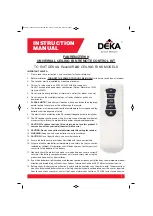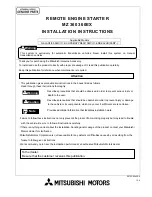
4
5
manual to confirm that external-starting assistance
is allowed.
• Follow these instructions and those published by
the battery manufacturer, vehicle manufacturer
and manufacturer of any equipment you intend to
use with this unit. Review warning labels on these
products and on the vehicle.
• This appliance is not designed to be used as a
replacement for a vehicular battery. Do not attempt
to operate a vehicle that does not have a battery
installed.
• The appliance must only be connected to a 12V lead-
acid battery. Do not use the appliance for charging
dry-cell batteries that are commonly used with home
appliances. These batteries may burst and cause
injury to persons and damage property.
• Check the polarity of the vehicle battery terminals
before connecting the appliance. Always disconnect
the negative (black) jumper cable first: followed by
the positive (red) jumper cable.
• The jump-starter power switch should be in the off
position before connection to a power source or
load, when the unit is charging and when not in use.
• Never allow the red and black clamps to touch each
other or another common metal conductor. This
could cause damage to the appliance and/or create a
sparking/explosion hazard. Always store the battery
clamps in the built-in holders when not in use.
• When using this unit in proximity to the vehicle’s
battery and engine, stand the unit on a flat, stable
surface, and be sure to keep all clamps, cords,
clothing and body parts away from moving parts of
the vehicle.
• This appliance contains a sealed lead-acid battery. It
is recommended that the appliance is laid flat during
storage, use, and recharging.
• Excessive engine cranking can damage a vehicle’s
starter motor. If the engine fails to start after the
recommended number of attempts, discontinue
jump-start procedures and look for other problems
that may need to be corrected.
• Do not charge the appliance using the 12V DC
charging adapter when the vehicle is occupied.
• Never attempt to use the mains and 12V DC
charging adapter simultaneously.
• Do not use this jump-starter on a watercraft. It is not
qualified for marine applications.
Warning! Burst hazard:
Do not use the unit for
charging dry-cell batteries that are commonly used
with home appliances. These batteries may burst
and cause injury to persons and damage property.
Use the unit for charging/boosting a lead-acid battery
only. It is not intended to supply power to a low-
voltage electrical system other than in a starter-motor
application.
Warning!
Explosive gas may be vented from lead acid
batteries when charging. The battery must be placed
in a well-ventilated area and you must remove any
sources of ignition when conducting jump starting
procedures.
• To reduce the risk of electric shock, disconnect the
appliance from any power source before attempting
maintenance or cleaning. Turning off controls without
disconnecting the appliance will not reduce this risk.
• Make sure the appliance is disconnected from all
charging power sources before beginning the jump
start procedure.
Additional safety warnings for
compressors
• For home and car use only. Inflate car and bike tyres,
balls, rafts, swimming pool floats, air mattresses,
and more in and around the home.
• Do not operate the compressor continuously
for extended periods of time (approximately 10
minutes, depending on ambient temperatures), as
it may overheat. In this event, the compressor will
automatically shut down. Immediately turn off the
compressor power switch. Restart the compressor
after a cooling down period of approximately 30
minutes.
• The compressed air from your compressor is
not safe for breathing. Never inhale air from your
compressor or from a breathing device connected to
the compressor.
• Inflate items only to their manufacturer’s
recommendations. Exceeding the pressure rating
could cause them to explode resulting in personal
injury.
• Do not leave compressor running unattended. It
could burst tyres or other items.
• Since the vibration produced by the compressor may
cause it to “walk”, do not operate on a high shelf or
other surface. Operate at ground or bench level.
• Do not modify or attempt to repair. Never drill into,
weld, or make any modifications to the compressor
or its attachments.
• Do not operate compressor when the car engine is
running.
• Operate only with the accessories included or those
rated for 8.28 bar/120 p.s.i. or higher. The use of any
accessory not recommended for use with this tool
could be hazardous.
• Do not play with the tool. High pressure air is
dangerous. Don’t direct air-flow at yourself or others.
• The compressor can become hot during use. Allow
compressor to cool for 30 minutes before storing
away.
• Never carry the compressor by the hose.
• This tool is not intended for use by persons
(including children) with reduced physical, sensory
or mental capabilities, or lack of experience and
knowledge, unless they have been given supervision
or instruction concerning use of the appliance by a
person responsible for their safety. Children should
be supervised to ensure that they do not play with
the appliance.
Specific safety instructions for power
inverters
Warning!
This appliance converts power from 12V
DC battery to 230-240V AC mains supply voltage. Take
precautions, including the following, to avoid the risk
of electric shock.
• Always turn the inverter off when not in use.
• Only connect a plug fitted to the supply cord of an
appliance to the inverter.
• Never connect an appliance by modifying the plug or
by using an adapter.
• Never connect an appliance that is damaged or
incomplete.
• Never connect the inverter to the output of another
inverter.
• Remove the appliance plug from the inverter before
performing any maintenance or before cleaning the
appliance.
• Do not cover the inverter. Only use in well ventilated
areas.
• Do not open the inverter, there are no serviceable
parts inside. Do not probe the inverter.
• Check that connections to the DC supply are clean
and secure. Loose connectors may cause overheated
wires and melted insulation.
• Do not install in engine compartments.
• Do not use the inverter to supply any medical
devices.
Warning!
Rechargeable devices:
Some
rechargeable devices do not operate well from a
modified sine wave inverter. They only operate
correctly from a standard household outlet
which provides a pure sine wave. Therefore, the
manufacturer recommends that you operate these
types of devices from a standard household outlet
only, not from the inverter.
This problem does not occur with the majority of
battery-operated equipment. Most of these devices use
a separate charger or transformer that is plugged into
an AC mains socket. The inverter is easily capable of
running most chargers and transformers.
Caution! Incompatible products:
Certain products
contain power supplies or circuits that are not
compatible with an inverter using a modified sine wave
output (such as this inverter) and may be damaged by
using this inverter.
Some products must be powered from a pure sine
wave power source, such as standard household
power, or a “pure sine wave” inverter in order to
function properly. If your product requires pure
sine wave AC input power to function properly, the
instruction manual for your product could state
this. If in doubt, you should contact your product
manufacturer PRIOR TO USE.
Your product could be damaged by this inverter if it
contains:
• Microwave ovens
• Transformerless battery chargers
• Capacitive coupled power supplies
If an incompatible product is used with this inverter:
• The product might not operate at all, with no
indication of failure. The product fuse might open as
a result of trying to use it with the inverter.
• The product might exhibit unusual operation (such
as, intermittent operation, buzzing, and the like.)
Some USB-powered household electronics may not
operate with this USB socket. Check the manual of the
corresponding electronic device to confirm that it can
be used with this type of USB socket.
Warning!
This appliance will not operate high wattage
appliances or equipment that produce heat, such as
coffee makers, hair dryers, microwave ovens, and
toasters.
Note:
Some laptop computers may not operate with
this inverter.
RATED VERSUS ACTUAL POWER REQUIREMENTS
OF EQUIPMENT
Most electrical tools, appliances and audio/video
equipment have labels that indicate the power
consumption in amps or watts. Be sure that the power
consumption of the item you wish to operate is rated
at 200 watts or less.
The power inverter is fitted with overload protection
and will shutdown if a load in excess of 200 W is
applied. Resistive loads (i.e incandescent lights) are
the easiest for the power inverter to run.
Additional safety instructions for
batteries and chargers
BATTERIES
• Never attempt to open for any reason.
• Do not expose the battery to water.
• Do not store in locations where the temperature may
exceed 40°C.
• Charge only at ambient temperatures between 4°C
and 40°C.
• Charge only using the chargers provided with the
appliance.
• When disposing of batteries, follow the instructions
given in the section “Protecting the environment”.
VG11AU_Manual_091216.indd 4-5
9/12/2016 12:01:18 PM
























